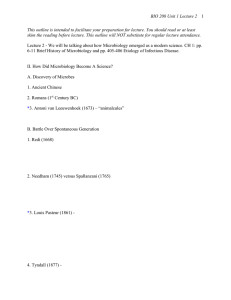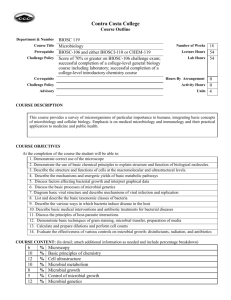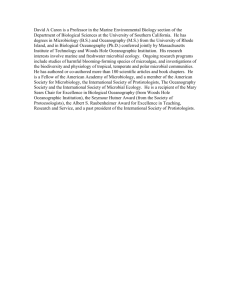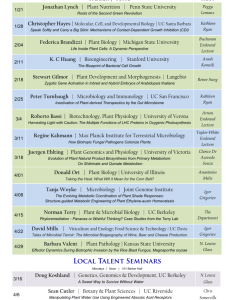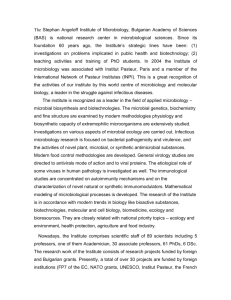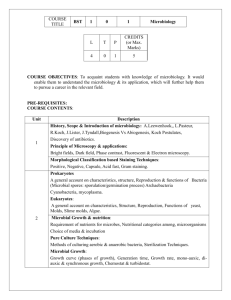Contents - Institute of Microbiology
advertisement
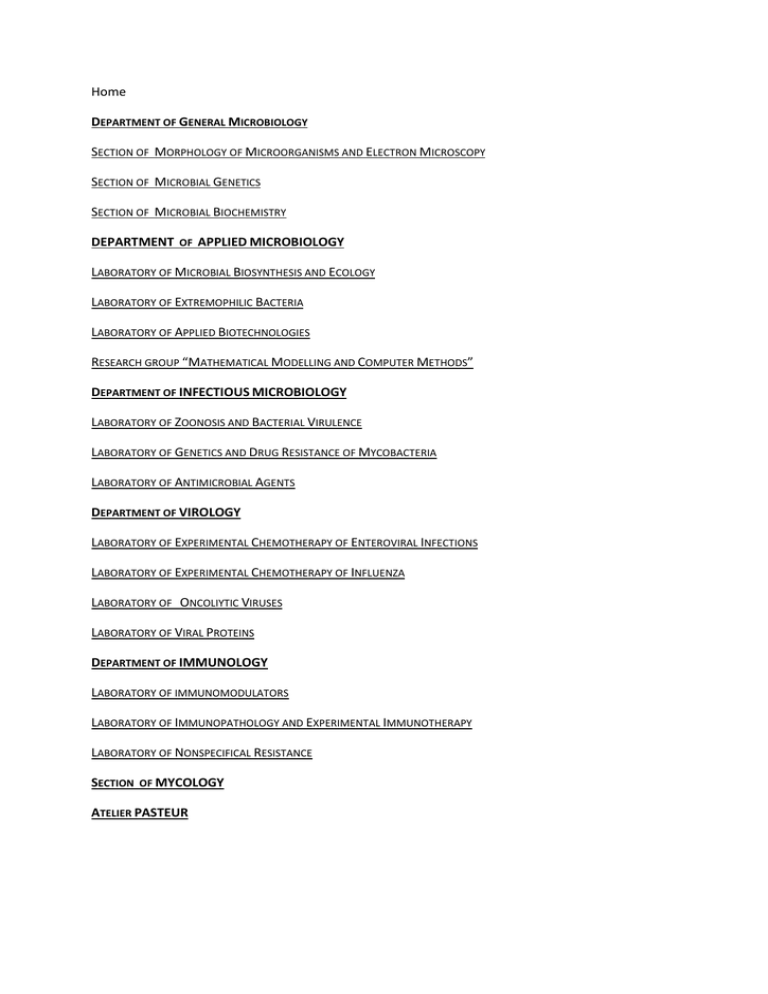
Home DEPARTMENT OF GENERAL MICROBIOLOGY SECTION OF MORPHOLOGY OF MICROORGANISMS AND ELECTRON MICROSCOPY SECTION OF MICROBIAL GENETICS SECTION OF MICROBIAL BIOCHEMISTRY DEPARTMENT OF APPLIED MICROBIOLOGY LABORATORY OF MICROBIAL BIOSYNTHESIS AND ECOLOGY LABORATORY OF EXTREMOPHILIC BACTERIA LABORATORY OF APPLIED BIOTECHNOLOGIES RESEARCH GROUP “MATHEMATICAL MODELLING AND COMPUTER METHODS” DEPARTMENT OF INFECTIOUS MICROBIOLOGY LABORATORY OF ZOONOSIS AND BACTERIAL VIRULENCE LABORATORY OF GENETICS AND DRUG RESISTANCE OF MYCOBACTERIA LABORATORY OF ANTIMICROBIAL AGENTS DEPARTMENT OF VIROLOGY LABORATORY OF EXPERIMENTAL CHEMOTHERAPY OF ENTEROVIRAL INFECTIONS LABORATORY OF EXPERIMENTAL CHEMOTHERAPY OF INFLUENZA LABORATORY OF ONCOLIYTIC VIRUSES LABORATORY OF VIRAL PROTEINS DEPARTMENT OF IMMUNOLOGY LABORATORY OF IMMUNOMODULATORS LABORATORY OF IMMUNOPATHOLOGY AND EXPERIMENTAL IMMUNOTHERAPY LABORATORY OF NONSPECIFICAL RESISTANCE SECTION OF MYCOLOGY ATELIER PASTEUR About us HISTORY The Institute of Microbiology was founded on March 7, 1947 as an institute of the Bulgarian Academy of Sciences (BAS) by the world-famous Bulgarian scientist Professor Stephan Angeloff, Member of BAS, who had been its first director for 15 years. Acad. Stephan Angeloff The foundation of the Institute of Microbiology realized the necessity for a formation of a research center with national importance, which to carry out contemporary investigations in rapidly developing and prosperous branches of microbiological science. The initial period in the development of the Institute (1947 - 1962) was connected with the studies of the actual after the Second World War infectious pathology of domestic animals and humans. The achievements in the study of the etiology and the development of diagnostic methods and immunoprophylactic preparations for different infections were significant. Investigations in the field of infectious immunology was set by Prof. Vladimir Markov, Member of BAS. Industrial microbiology started with the studies of Prof. Ignat Emanuilov, Member of BAS, on the microbiology of milk and dairy products, biochemistry and physiology of lactic acid bacteria and the application of bacterial enzymes (proteinases) in cheesemaking. Along with bacteria as producers of biologically active substances filamentous fungi were investigated. In the field of microbial morphology since 1964 electron microscope studies of bacteria, filamentous fungi, yeasts and cells of the immune system of the macroorganism were performed. The investigations in the field of microbial biochemistry after 1973 aimed the elucidation at modern biochemical level of the main peculiarities in the physiology and biosynthetic capabilities of the microbial cells: various enzymes, proteinase and nuclease inhibitors, microbiological transformation of steroids, protein-lipid interactions in bacterial membrane. Systemic investigations carried out by Prof. Simeon Galabov and his collaborators on the relationship between antigenic structure and biological properties of bacterial endotoxins resulting in development of diagnostic kits and vaccines, as well as data on interferon-inducing activity. The research work in the field of microbial genetics was connected with the problem of prophage interference, genetic transfer in Bacillus thuringiensis and Streptococci from group A, hybridization of Actinomyces sp. in order to increase their productivity, construction of gene maps of Streptomycetes - producers of antibiotics, molecular identification of microorganisms by the use of PCR, as well as genomic differentiation by M13 DNA fingerprinting and ribotyping. The Institute of Microbiology has always played a leading role in applied microbiology. Microbial producers of a wide spectrum of biologically active substances were isolated: enzymes, aminoacids proteins, carotinoids, and various antibiotics with different spectrum of activity were isolated. Physiology and biochemistry of microbial producers, including extremophilic bacteria as well as the properties of the synthesized products were studied. A wide spectrum of methods for immobilization of enzymes and microbial cells, producers of biologically active substances, were elaborated. The investigations in infectious bacteriology after 1962 were pointed on the changes provoked in the pathogen during the course of infectious and immunizatory process. Later, studies were focused on the factors and mechanisms of bacterial virulence and bacteriahost interactions. At the beginning of 60th years started investigations in the field of the experimental chemotherapy of viral infections. Systemic studies on the creation and characterization of some new effective antivirals, on the combined effects of viral inhibitors and their mechanisms of action. Iinvestigations on cell immunity and L-forms of bacteria and a widespectrum immunopharmacological screening was performed aiming the selection of new active substances. MISSION The Stephan Angeloff Institute of Microbiology, Bulgarian Academy of Sciences (BAS) is national research center in microbiological sciences. It is one of the leading institutes in the field of microbiology for South-Eastern Europe. By its wide research area the Institute is unique among the other institutes from the Pasteur family. The institute is recognized in Europe and worldwide for its modern research tendencies. Ever since its foundation 60 years ago, the Institute’s strategic lines have been: (1) investigations on problems implicated in public health and biotechnology; (2) teaching activities and training of PhD students. In 2004 the Institute of microbiology was associated with Institut Pasteur, Paris and a member of the International Network of Pasteur Institutes (INPI). This is a great recognition of the activities of our institute by this world centre of microbiology and molecular biology, a leader in the struggle against infectious diseases. THE STEPHAN ANGELOFF INSTITUTE OF MICROBIOLOGY NOWADAYS The Institute comprises 11 departments and a staff of 171 including 6 professors, one of them Corresponding Member of BAS, 34 associate professors and 52 research scientists. The expertise areas are: morphology and ultrastructure, genetics, biochemistry, physiology and ecology of microorganisms, mycology, virology, infectious microbiology and immunology. The efforts are currently concentrated on some key practical problems of public health, drug design, food safety, biotechnology, and environmental protection. Research scientists Corresponding member of BAS – 1 Professors – 4 Research Scientists - 53 Scientific degree holders: Age to 35 – (24,2%) Research Assistants with MD, DVM, MS, PhD high university degree - 45 Doctor of sciences, DSc -7 Research Assistants, PhD – 2 Promotion of the research scientists during 1999 - 2007 Title Promotion 1999 2000 2001 2002 2003 2004 2005 2006 2007 Corresponding 1 member Professors 1 1 Assoc. Professors 2 1 Research 3 6 2 1 14 1 4 16 4 8 scientists BUDGET FOR 2007 Income Government subsidy 1 Levs (BGN)* 1 427 000. 00 4 10 Foreign currencies projects 176 778. 00 Projects, supported by Ministry of Education and Science and the Innovation fund of Ministry of 507 850. 00 Economics Other projects 46 700. 00 Rent, prizes etc. 30 968. 00 Total incomes: 2 189 296. 00 FIELDS OF SCIENTIFIC RESEARCH RELATED TO PUBLIC HEALTH Experimental chemotherapy of emerging and re-emerging viral infections (influenza, enteroviral, flaviviral and others) Pathogenesis of some infectious diseases and additives in complex therapy Oncogenic and oncolytic viruses Balkan Endemic Nephropathy Virucidal agents Tuberculosis – molecular characterization of drug-resistant strains of Mycobacterium tuberculosis Bacterial zoonosis Bacterial virulence New antiviral and antimicrobial agents New approaches for bacteriological monitoring of food products Vaginal lactobacilli Resistance to antiviral and antimicrobial agents Mechanisms of autoimmune diseases New vaccines technologies Microbial biosynthesis of steroids and other biochemicals Galantanamin (nivalin) production technology MAIN RESEARCH TOPICS IN APPLIED MICROBIOLOGY AND MICROBIAL ECOLOGY Molecular taxonomy of microorganisms Molecular genetic of microorganisms of biotechnological and medical significance Ultrastructure of saprophytic and pathogenic microorganisms Regulatory mechanisms of microbial metabolism Cell response against different type of physiological stresses and mechanisms of adaptation of bacteria and fungi Biological activity and potential of lactic acid bacteria as bioprotective starters for dairy products and their probiotic properties for human health. Microbial surfactants (biosurfactants) – biosynthesis, isolation, mechanism of action and application Novel microbial antibiotics Microbial biosynthesis of biological-active compounds: enzymes, amino acids, growth factors etc. Microbial transformation of steroid compounds Ecological biotechnologies Purification of water and soil from heavy metal Production of biogas Biosynthesis of biological active compounds by plant suspension cultures Biodiversity, ecology and biotechnological potential of extremophilic microorganisms Microbial degradation of aromatic compounds RESEARCH PROJECTS The research work of the Institute is funded on project principle. Program European commission 4 Framework Program 5 Framework Program 6 Framework Program Number 6 1 3 Program Leonardo da Vinci NATO UNESCO Program ACIP of IPPI Institutes from the network of Pasteur’s Institutes German center of cancer research 4 13 1 2 1 2 Foundations in Germany Ministry of education, science and culture, Austria Ministry of science and culture, Белгия 3 4 1 Total number 39 Research projects 1997 – 2007: PROJECTS DURING THE LAST FOUR YEARS Years Projects, financed by Ministry of education and science Ministries and institutions in Bulgaria 2004 2005 2006 2007 42 50 53 61 4 3 6 4 ЕС NATO Programs between Companies in Total International UNESCO etc. academics and Bulgaria and number of projects institutes abroad projects 10 11 13 15 17 12 15 14 13 6 8 5 86 82 95 99 There is a stable tendency of raising the number of projects.Current research projects are supported by foreign and Bulgarian grants: a total of 35 projects by foreign institutions (2 by FP6 of the EC, 9 by NATO grants, 1 by UNESCO, 3 by ACIP program of INPI, 1 by the French governmental foundation, 1 by the Swiss governmental foundation, 2 by Deutsches Krebsforschung Zentrum and 6 by research and development centers of foreign companies), and 40 - by the National Science Research Fund at the Ministry of Education and Science, Bulgaria. INTERNATIONAL COOPERATION The Institute’s activities are widely based on international cooperation, with projects between two or more institutions. We are searching for new projects as part of the international research programs. Scientists from the Institute are respected partners for different scientific organizations abroad, companies, institutes and laboratories. During 2007 the Institute has been involved in 40 international projects and joint studies, 15 of which were financed through EC, NATO, UNESCO and other programs, 18 of them were developed within the frames of academic and institute cooperation, and 7 were financed from companies abroad. 35 29 33 33 New scientific bridges have been created between the IMSA and the Saint-Petersburg Institute Pasteur and Institute Pasteur of Guadeloupe (drug-resistant Mycobacterium tuberculosis), Institute Pasteur Paris (human papillomaviruses, genetics of primary HBV/HCVinduced liver carcinoma), German Center of Cancer Research (DKFZ, Heidelberg) (oncolytic viruses), University of Leipzig and the Technical University of Dresden (plant cell cultures and biotechnologies), University of Viterbo and University of Pavia (new enzymes of Antarctic microorganisms), University of Strathclyde, Glasgow (biotechnologies of eukaryotic microorganisms), University of Naples (enzymes from thermopile bacteria) and Institute of Agricultural Sciences and Fishery, Ghent (control on food products), etc. Some of the dissertation works are part of the international partnership, which finalize as dissertation theses supervised by scientists from the Institute of microbiology and from RIIP, CNRS (France) and others. During 2007 the scientists from our institute took part in 79 scientific forums abroad, 25 foreign scientists have visited the institute; 7 specializations and workshops were taken from students from our institute abroad. Researchers from our institute had 22 business trips related to organization and scientific work and lecturing. Our young colleagues specialized in foreign institutes in Germany, France, Spain and others. JOINT ACADEMIC PROJECTS AND PROJECTS BETWEEN INSTITUTES 1997 – 2007 France Germany Russia R. Macedonia Slovakia 4 USA Italy Ukrain Latvia Taiwan Check R. Hungury 2 1 2 1 2 1 1 2 1 8 5 TOTAL NUMBER 28 INNOVATIONS AND BUSINESS RELATIONS The IMicB has opened an Innovations office, which provides information, ideas, and workshops for the proper use of EC funds, help to prepare applications in EC program’s calls, etc. There are materials available for everybody who has interest. The institute of microbiology has participated to the International fair in Plovdiv on the advertising table of BAS, where we have presented achievements in the area of microbial biotechnology. A new catalog came out to the interested in this area about the created novel technologies of extracting biologically active substances and possibilities for expertise (supplementary 1). National innovation fund is financing development of technologies, associated with national mile stones and related to the production of energy from biogases, new biomaterial products with application in farming, immunostimulation reagent for treatment of tumors on animals and diagnostic and therapeutic bioproducts. The group of innovation achievements includes also the ones financed by Ministry of education, science and culture on the national scientific programs Genomic, New technologies in the power supply and Nanotechnologies. Main priority of these programs is achieving new knowledge and creation of modern technologies in important areas. As an associated member of Institute Pasteur, IM participates in modern research of 4 different areas, which is one of the most important health problems of our time – tuberculosis, papiloma and hepatit viruses – factors, which provokes cancers and infectious arthritis. PROJECTS WITH COMPANIES FROM BULGARIA AND ABROAD Projects with companies from Bulgaria and abroad Number Germany 12 France 3 Holland 1 Denmark 3 Switzerland 1 Japan 1 Turkey 1 UAR 1 Total number 23 Joint projects with Bulgarian companies Total number 25 projects financed by the ministry of education, science and culture universities and other institutions Average per year 60 There are also projects, financed by Ministry of education, science and culture ЕС, NATO and the partnership associated with the innovation problems – isolation of new producents of biologically active substances of extreme territories, isolation and characterization of probiotic products, new technologies for obtaining energy and electrical power from organic matter, obtaining new drugs to treat sepsis based on biological weapons; new methods and strategies in the treatment of bacterial and virus diseases, biodegradation of toxic pollutions, isolation and use of biosurfactants, etc. Projects related to the production of Bulgarian yogurt deserve special attention, which is due to the achievements of the IM to obtain patent certificate. The IMicB is also a partner in agricultural work, which has been ordered in cooperation with foreign companies and such ones from Bulgaria. There are many examples where our institute is a solo scientific organization, which works on problems created directly from thing the effect of imodin in experimental infection with flue virus, estimation of the protection effect of substances against pseodotuberculosis, microbiological analysis of chemical predrugs and final drug products and its trade packages. RESEARCH ACHIEVEMENTS Infectious Microbiology Characterization of bacterial-host interactions (invasion, persistence, intracellular survival, as well as the bioenergetic mechanisms ensuring these processes) at experimental melioidosis, lysteriosis, yersiniosis and salmonelosis. Application of Yersinia outer membrane proteins in improved ELISA and immunoblot tests for diagnosis of yersiniosis in humans, pigs and rabbits. Development of new generation of live carrier vaccines by using genetically constructed mutants of Yersinia enterocolitica and Yersinia pseudotuberculosis. lucidation the role of Yersinia LPS antigen in induction of reactive arthritis in experimental models. Molecular epidemiological analysis (population structure included) of the incidence and transmission of multidrug-resistant Mycobacterium tuberculosis strains in Bulgaria by using a complex of molecular bioiological methods and population structure analysis. The multidrug resistant and hypervirulent Beijin strain was not found in Bulgaria. The results contributed to the control the global spread of multidrug tuberculosis worldwide. The photoinhibitory effect applicable in the practice for photosterilization of contaminated with enterobacteria water ecosystems. Optimization and application of PCR-DGGE for direct detection and typing of Campylobacter jejuni and Campylobacter coli in caecal samples of broilers without preliminary enrichment. This method allows reliable and fast detection and identification of pathogenic Campylobacters infections in humans. Development of a lectin-based approach for differential labeling of Escherichia coli exopolysaccharide, O and K antigens and its application for complex characterization of antigen variations by microagglutination, ELLA, ligand blotting, immunoelectrophoresis and lectin-gold. The Pomorie mud as an inductor of enzyme neuraminidase secretion at pathogenic genera Vibrio and Aeromonas. Original newly isolated lactobacillus strains with biological activity and potential to both preserve the healthy homeostasis of the vagina, and as gastrointestinal probiotics. Characterization of uridine-monophosphate kinases of Streptococcus pneumoniae and Escherichia coli as potential targets for development of specific antibacterial agents. Virology Discovery of new original antiviral substances effective in the treatment of viral infections in humans: - Guanidine derivative - chemotherapeutic agent, inhibiting replication of adenoviruses, effective in the treatment of epidemic keratoconjunctivitis and other adenovirus conjunctivitides (widely spread viral infections of the eye). It is the first known antiadenoviral chemotherapeutic agent. - Dipyridamole - a large spectrum antiviral agent, acting via induction of endogene interferon, used for prevention of flu and other acute viral respiratory infections. Clearing-up of the mode of antiviral action of mopyridone on influenza A virus replication (binding to the structural M1 protein). Discovery and characterization of the antiviral effect of cycluridine towards flavivirus infections, the first chemotherapeutic agent efficacious in the mucosal disease-virus diarrhoea in cattle. Establishment of synergistic combination effect of rimantadine and oseltamivir against influenza virus A (H3N2) experimental infection. Clearing-up of the drug-resistance phenomenon in enterovirus replication inhibitors interacting with the viral capsid protein VP1 – problems of the development of highly effective anti-enteroviral chemotherapy. Phenotype and molecular genetic characteristics of disoxaril resistant and dependent mutants of Coxsackie virus B1. Discovery of a series of highly efficient synergistic combinations of enteroviral replication inhibitors – a perspective approach for dissolving the drug-resistance problem. Discovery of oxoglaucine: a highly effective and large-spectrum inhibitor of enterovirus replication. Establishment of the anti-influenza virus effects of novel protease inhibitors from Streptomyces. Determination of the role of the oxidative stress in the pathogenesis of flu and the influence of certain antioxidants of natural and synthetic origin and antivirals on this process. Determination of the antiviral spectrum of the highly effective and broad-spectrum virocidal composition of new type (Manorapid Synergy®), implemented in the clinical practice as hand disinfectant. Characterization of the immune state and the role of hantavirus infections in etiopathogenesis of the Balkan endemic nephropathy. Describing of the phenomenon of inflammation-induced enhancement of IgG antigen binding polyreactivity. Development of DNA vaccines with a new type of build-in adjuvanticity. General and Applied Microbiology Molecular epidemiological study of the role of human papillomaviruses in etiology of CIN and cervical cancer in Bulgarian population. Establishment and characterization of the cancerolytic effect of some parvoviruses. Immunology Establishment of the ability of the opportunistic yeast Candida albicans to induce reactive arthritis in normal and in predisposed individuals. Analysis of the relationship between infections and rheumatic diseases contributed to the development of new therapeutic approaches. Establishment and characterization of the immunomodulatory properties of coumarin, 7hydroxycoumarin, yeast superoxide dismutase and molluscan hemocyanins. They have therapeutic potential as antitumor agents as well as for the prophylaxis of infectious diseases. Discovery of previously unknown mechanisms of the immunomodulatory activity of pooled IgG (IVIg) in autoimmune patients. Development of experimental improved “nextgeneration” pooled human immunoglobulin preparation with an improved therapeutic effect in systemic inflammatory diseases. Describing of the immunomodulatory potential of normal pooled human IgM in autoimmune and inflammatory diseases. Development of a novel approach for silencing selectively autoreactive disease-associated B cells in autoimmune diseases. Original evidence about the fine structural changes of model Gram-positive and Gramnegative bacteria under the action of rhamnolipid-biosurfactant with surfaceactive properties. Ultrastructural peculiarities, the growth and reproductive capacity of producers of thermostable exo-inulinase and cyclodextrin glucanotransferase immobilized on different matrices. Ultracytochemical localization of acid phosphatase in nongerminating and germinating conidia of the fungus Humicola lutea. Development of a simple and rapid test for differentiation of aerobic from anaerobic bacteria applicable for determination of the respiratory type of pure cultures isolated from different areas of the environment. New evidence for the relationship between oxidative stress and various environmental challenges (heavy metals, heat- or cold-shock, cell immobilization). Evidence for unusual existence of Cu/Zn-SOD in mitochondrial intermembrane space Microbial transformation of the steroid compounds sitosterol and androstenedione was performed by resting cells of Mycobacterium sp. and Rhodococcus sp., respectively, in a single phase organic solvent based medium. Isolation and characterized of biosurfactants of microbial origin applicable in biomedicine, bioremediation and biotechnology. Identification of catabolic genes, coding enzymes with phenol-hydroxilase activity at the original yeast strain Trichosporon cutaneum R57 possessing high activity in degrading aromatic and aliphatic compounds Original approaches to the moleculartaxonomic characterization of lactic acid producing bacteria and the rapid monitoring of Lactobacilli from different ecological niches. The genetic, physiological and other factors, controlling the sexual process of the yeast Hansenula polymorpha. A method for production of extra cellular αgalactosidase by submerged cultivation of Aspergillus niger M47 , Penicillium chrisogenum LN33 and Humicula lutea 1205 on the medium, composed by wastes from food industry. Technologies” for production of L-lysine and Lvaline. Preparation of starters for fermented milks with health benefits by the bacteriocin producers Lactobacillus bulgaricus BB18 and Lactobacillus lactis BCM5 and their compatible strains Streptomyces thermophilus 11A and Lactobacillus bulgaricus LX1 Genetic identification of Streptomyces iakurus DSM 41873., producer of antibiotic complex, composed of 5 chemically characterized new components. Characterization of phytase isolated from Antarctic yeats. Technology for galanthamine production by Leucojum aestivum shoot culture Determination of genome size of Beta vulgaris cells by flow cytometry. Development of immobilized system for removal of Cu (II), Co (II) and Fe (III) ions from ternary mixed aqueous solutions using fungal biomass entrapped in hydrophilic organic polymer. Development of high effective technology for biosynthesis of naturally glycosylated Cu/ZnSOD by the fungal strain Humicola lutea 103. The novel enzyme demonstrated protective effect against Graffi tumor and influenza virus infection, as well as improves fertility of ram and bull spermatozoa during liquid storage and cryoconservation. Isolation from Bulgarian hot springs and characterization of novel bacterial species (Anoxybacillus rupiensis, Anoxybacillus bogrovensis) possessing significant biotechnological potential. Isolation of thermophilic Bacillus strains with potential for application in chemical synthesis or various detoxification processes, used as biocatalyst in the synthesis of cyclodextrin glucanotransferase and producers of thermostable gellan lyase. Optimisation and control algorithms and laboratory biogas technologies for the anaerobic digestion of organic wastes (specific and in mixtures), accompanied by biogas yield. EDUCATIONAL ACTIVITIES The educational activities of the Institute include: PhD tuition (35 PhD students within the last five years); training courses for young scientists from the Balkan countries at the Atelier Pasteur on modern methods in microbiology with lecturers from INPI; participation in the Leonardo da Vinchi Programme of EC. Thirteen scientists from the Institute give lectures at nine Bulgarian universities. Medical university Faculty of biology, University of Sofia “St. Kliment Ohridski” Faculty of Veterinary Medicine, University of Forestry Technical University of Sofia New Bulgarian University Technical University – Gabrovo University “Asen Zlatarov” – Burgas University of Food Technology – Ploviv Scientists from the institute are involved in academic activities at: During 2007, a total of 22 PhD and 12 MS theses are prepared at the Institute; Form of education Number of Students Graduated PhD REGULAR 10 1 EXTRAMURAL 1 -- 8 2 STUDIES INDIPENDENT TOTAL MS theses’s prepared during 2007 on request from: Number of PhD 19 Faculty of biology, University of Sofia “St. Kliment Ohridski” -10 Faculty of chemistry, University of Sofia “St. Kliment Ohridski” – 2 Technical University of Sofia – 3 3 EXPERT ACTIVITIES Scientists from the Institute participate in scientific councils of academic and other research institutions, editorial boards of international and national scientific journals, in the boards of international and Bulgarian scientific societies, members of advisory board of WHO. IMicB was the initiator of the establishment of the Balkan Society for Microbiology, and is the head quarter of this society and the Bulgarian Society for Microbiology. Consultancy is provided for many institutions (governmental, university, private etc) about public health, agriculture, food industry, ecology and environment. Scientists are included in the work of many expert groups among which Expert Council for Biological Defence at the governmental Committee for Prevention of the Population from Natural Disasters and Catastrophes, Expert Council for Epidemiological Control of Infectious Diseases and Immunoprophylaxis, Commission for Eradication of Polyomyelitis at the Ministry of Public Health, Expert Group on Countering the Effects of Biological and Chemical Terrorism at EC, National Agencies of Standardization and Authorization, etc. PUBLISHING ACTIVITIES: Short synoptical collection (Scientific Report) in English is annually published. Recently is reestablished the journal of Institute of Microbiology “Stephan Angeloff” – Acta Microbiologica Bulgarica. Efforts have been done for participation to Bulgarian Information Consortium. The Institute’s library is registered at the Conference of European National Libraries – CENL, and joined the National Educational Forum. Research results are extensively published in scientific journals, monographs and meeting proceedings. http://www.microbio.bas.bg Staff Projects Reports Contacts Institute of Microbiology, BAS Acad. G. Bonchev Str., Bl. 26, Sofia 1113, Bulgaria Phone: (+359 2) 979 31 57; Fax: (+359 2) 870 01 09; E-mail: micb@microbio.bas.bg
